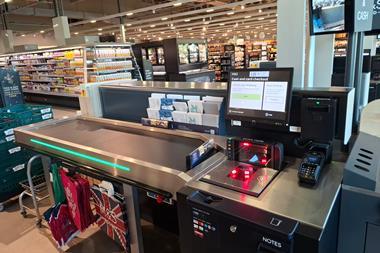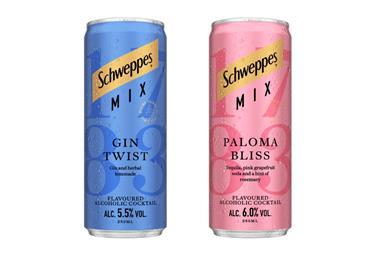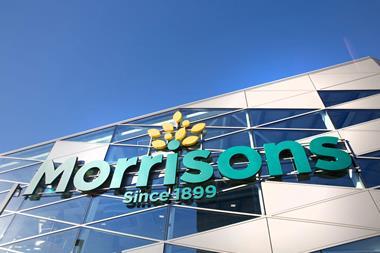Why are so many of the finest food stores in the US? Isn’t it just a nation of fatties who eat junk food, asks Siân Harrington
“The top companies retail good food first and organic/ natural food second… good food crosses boundaries, from plumbers and lawyers to builders and nannies”
Format Development
Albert Heijn
Category Manager
Marks & Spencer
Director, Category and customer straTegy
Unilever Foods North America
Managing Director
Smucker Foods of Canada
The United States - home to the most overweight people in the world. A nation of fatties who waddle down the streets (or squash into their oversized pick-up trucks) stuffing their faces with fast food as captured so well in Morgan Spurlock’s film Super Size Me and Eric Schlosser’s book Fast Food Nation. Or obese moms and pops dragging their kids down the aisles of Wal-Mart while throwing sugar-loaded products into trolleys.
According to the US National Centre for Health Statistics, 30% of US adults aged over 20 are obese, more than 60 million people. And the percentage of young people who are overweight has tripled since 1980. Among six to 19-year-olds, 16% (nine million people) are overweight.
But hold on. If Americans have an unhealthy relationship with food, how come four of the 10 finest supermarket retailers in the world and three of the top 10 specialist food stores, as voted for by our academy, are based in the US? Especially when what marks out many of these retailers is their passion for good, fresh and, in some cases, healthy organic food.
Michael Duff, senior editor at US industry magazine DSN Retailing Today, says the US media paints a lopsided picture of the US diet. The overall population is more than 298 million, of which Hispanics make up more than 13% and black Americans 13% [Census 2002]. Duff points out that the sheer size of the country, plus this diverse cultural population, has fostered a heterogeneous food industry.
On one side, you have the 32oz steak and ‘All You Can Eat for $5’. On the other, the US West Coast - and in particular California - is the home of vegetarianism, the organic movement and macrobiotics - not to mention the vast array of faddish diets that celebrities follow.
“America is not the singular place often represented by US media. As is the case in most countries, including Britain, activists won’t hesitate to warp or exaggerate. If you read the health news on the Reuters wire, for example, you would think that all Britons were chain smokers who have a psychotic aversion to safe sex while living permanently attached to a pint glass,” Duff says.
In actual fact it’s not the US population as a whole that is getting fatter, he says, but the fattest people becoming fatter still. While a 300-pound (21 stone) person was once considered huge, the US now boasts 400-pounders (28 stone). Much of this has been due to the deflation in food prices in the US over the years, particularly in areas of intense competition such as fast food restaurants and snacks. This gives those inclined to consume fatty food a greater ability to do so.
However, the US’s appetite for healthy foods is also bigger. Since food scares in the 1980s and 1990s, sales of organic and natural food have been booming - explaining the popularity of retailers such as Whole Foods Market and Wild Oats Natural Marketplace.
Although interest waxes and wanes in tandem with safety issues, more consumers get pulled in during each scare and some remain at least part-time users, says Duff. The result is that mass and mid-market supercentres have developed permanent organic and natural food sections. Even Wal-Mart offers about a dozen organic SKUs.
According to a US Department of Agriculture Study, organic farming is one of the fastest-growing segments of agriculture. For example, the acreage of organic cropland for corn, soybeans and other cereals more than doubled from 1992 to 1997 and doubled again between 1997 and 2001, while organic poultry and dairy grew even faster.
Indeed, in 2000, sales of organic products in conventional supermarkets were higher than organic sales in non-supermarket outlets for the first time and growth in organic retail sales has equalled 20% or more annually since 1990 [Economic Research Service, US Department of Agriculture].
So it’s no surprise that retailers such as Whole Foods Market and Wild Oats Natural Marketplace should spring up to satisfy this consumer trend. “The appeal of these outlets should come as no surprise, given the increasing focus on provenance and authenticity and concern about healthy eating and natural ingredients,” says Maureen Johnson, chief executive of The Store, WPP’s integrated retail marketing practice.
Other countries are tapping into this trend, but it is the way the US retailers market their organic focus that has allowed them to shine. Johnson adds: “These trends are being picked up in the UK’s leading supermarkets, but stores such as The Vinegar Factory, Dean & DeLuca and Whole Foods Market allow you to immerse yourself in this world. Meanwhile, Trader Joe’s sources and creates access to the exotic and the authentic and fascinates with stories about their provenance. And we all love stories.”
Duff says hard-core organic consumers have been turning against the two major organic retailers - Whole Foods and Wild Oats - believing they are too corporate, not dedicated to natural food and operating against the spirit of the movement.
But the popularity of these retailers, as well as the likes of Wegmans and Trader Joe’s, with mainstream consumers is a result of their gourmet orientation in perishables and processed food. “These stores have relevance to consumer needs, drivers and aspirations,” says Kevin Coupe of US retail website morningnewsbeat.com.
“Five years ago if you said ‘organic food’ you might as well have said ‘cardboard’. These companies retail good food first and organic/natural food second.
“Wegmans creates food culture. It has shown that really good food crosses boundaries, from plumbers and lawyers to construction guys and nannies. It is not just a high-end product, and when Wegmans walks into a market it has an enormous impact.”
Healthy eating is a major trend, while products with an enhanced nutrional component are also making waves, particularly Omega-3, the health benefits of which resulted in the first major jump in seafood consumption in 15 years. Locally sourced foods are also gaining kudos, as they are considered fresher and more wholesome.
“These trends hold true throughout the US,” says Duff. “Whole Foods and Wild Oats are based in Colorado and organic, natural, healthy and local foods have backers throughout the US. The perception that these are coastal trends is as much a reflection of where the media is than anything else.”
Ineke Verdonkschot
Richard Flint
Kimberly Senter
Mark Smucker
“The top companies retail good food first and organic/ natural food second… good food crosses boundaries, from plumbers and lawyers to builders and nannies”
Format Development
Albert Heijn
Category Manager
Marks & Spencer
Director, Category and customer straTegy
Unilever Foods North America
Managing Director
Smucker Foods of Canada
The United States - home to the most overweight people in the world. A nation of fatties who waddle down the streets (or squash into their oversized pick-up trucks) stuffing their faces with fast food as captured so well in Morgan Spurlock’s film Super Size Me and Eric Schlosser’s book Fast Food Nation. Or obese moms and pops dragging their kids down the aisles of Wal-Mart while throwing sugar-loaded products into trolleys.
According to the US National Centre for Health Statistics, 30% of US adults aged over 20 are obese, more than 60 million people. And the percentage of young people who are overweight has tripled since 1980. Among six to 19-year-olds, 16% (nine million people) are overweight.
But hold on. If Americans have an unhealthy relationship with food, how come four of the 10 finest supermarket retailers in the world and three of the top 10 specialist food stores, as voted for by our academy, are based in the US? Especially when what marks out many of these retailers is their passion for good, fresh and, in some cases, healthy organic food.
Michael Duff, senior editor at US industry magazine DSN Retailing Today, says the US media paints a lopsided picture of the US diet. The overall population is more than 298 million, of which Hispanics make up more than 13% and black Americans 13% [Census 2002]. Duff points out that the sheer size of the country, plus this diverse cultural population, has fostered a heterogeneous food industry.
On one side, you have the 32oz steak and ‘All You Can Eat for $5’. On the other, the US West Coast - and in particular California - is the home of vegetarianism, the organic movement and macrobiotics - not to mention the vast array of faddish diets that celebrities follow.
“America is not the singular place often represented by US media. As is the case in most countries, including Britain, activists won’t hesitate to warp or exaggerate. If you read the health news on the Reuters wire, for example, you would think that all Britons were chain smokers who have a psychotic aversion to safe sex while living permanently attached to a pint glass,” Duff says.
In actual fact it’s not the US population as a whole that is getting fatter, he says, but the fattest people becoming fatter still. While a 300-pound (21 stone) person was once considered huge, the US now boasts 400-pounders (28 stone). Much of this has been due to the deflation in food prices in the US over the years, particularly in areas of intense competition such as fast food restaurants and snacks. This gives those inclined to consume fatty food a greater ability to do so.
However, the US’s appetite for healthy foods is also bigger. Since food scares in the 1980s and 1990s, sales of organic and natural food have been booming - explaining the popularity of retailers such as Whole Foods Market and Wild Oats Natural Marketplace.
Although interest waxes and wanes in tandem with safety issues, more consumers get pulled in during each scare and some remain at least part-time users, says Duff. The result is that mass and mid-market supercentres have developed permanent organic and natural food sections. Even Wal-Mart offers about a dozen organic SKUs.
According to a US Department of Agriculture Study, organic farming is one of the fastest-growing segments of agriculture. For example, the acreage of organic cropland for corn, soybeans and other cereals more than doubled from 1992 to 1997 and doubled again between 1997 and 2001, while organic poultry and dairy grew even faster.
Indeed, in 2000, sales of organic products in conventional supermarkets were higher than organic sales in non-supermarket outlets for the first time and growth in organic retail sales has equalled 20% or more annually since 1990 [Economic Research Service, US Department of Agriculture].
So it’s no surprise that retailers such as Whole Foods Market and Wild Oats Natural Marketplace should spring up to satisfy this consumer trend. “The appeal of these outlets should come as no surprise, given the increasing focus on provenance and authenticity and concern about healthy eating and natural ingredients,” says Maureen Johnson, chief executive of The Store, WPP’s integrated retail marketing practice.
Other countries are tapping into this trend, but it is the way the US retailers market their organic focus that has allowed them to shine. Johnson adds: “These trends are being picked up in the UK’s leading supermarkets, but stores such as The Vinegar Factory, Dean & DeLuca and Whole Foods Market allow you to immerse yourself in this world. Meanwhile, Trader Joe’s sources and creates access to the exotic and the authentic and fascinates with stories about their provenance. And we all love stories.”
Duff says hard-core organic consumers have been turning against the two major organic retailers - Whole Foods and Wild Oats - believing they are too corporate, not dedicated to natural food and operating against the spirit of the movement.
But the popularity of these retailers, as well as the likes of Wegmans and Trader Joe’s, with mainstream consumers is a result of their gourmet orientation in perishables and processed food. “These stores have relevance to consumer needs, drivers and aspirations,” says Kevin Coupe of US retail website morningnewsbeat.com.
“Five years ago if you said ‘organic food’ you might as well have said ‘cardboard’. These companies retail good food first and organic/natural food second.
“Wegmans creates food culture. It has shown that really good food crosses boundaries, from plumbers and lawyers to construction guys and nannies. It is not just a high-end product, and when Wegmans walks into a market it has an enormous impact.”
Healthy eating is a major trend, while products with an enhanced nutrional component are also making waves, particularly Omega-3, the health benefits of which resulted in the first major jump in seafood consumption in 15 years. Locally sourced foods are also gaining kudos, as they are considered fresher and more wholesome.
“These trends hold true throughout the US,” says Duff. “Whole Foods and Wild Oats are based in Colorado and organic, natural, healthy and local foods have backers throughout the US. The perception that these are coastal trends is as much a reflection of where the media is than anything else.”
Ineke Verdonkschot
Richard Flint
Kimberly Senter
Mark Smucker













No comments yet